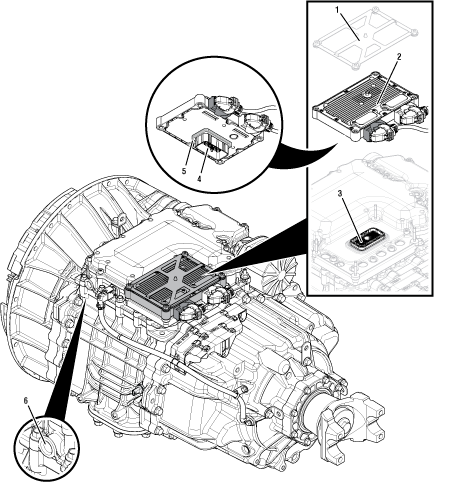Fault Code 780: Rail E Operation
J1939: SA 3 SPN 6148 FMI 0, 1, 2, 7, 10, 14, 15, 16, 17, 18, 20, 21
Overview
The Mechatronic Transmission Module (MTM) is equipped with solenoids to direct pneumatic flow to actuate shift rails and sensors to monitor rail positions. The Transmission Control Module (TCM) compares the rail command and position to ensure proper rail operation. The solenoids, positions sensors and shift rails are located in the MTM and connected to the TCM at the 74-Way Transmission Harness Connector.
Detection
The TCM monitors the Rail E Operation. If a system failure is detected, the fault is set active.
Conditions to Set Fault Code Active
FMI 0 – Data Valid But Above Normal (Most Severe): Rail E is unable to disengage High Range, move aft, for 2 seconds.
FMI 1 – Data Valid But Below Normal (Most Severe): Rail E is unable to disengage Low Range, move fore, for 2 seconds.
FMI 2 – Data Erratic: During a Rail Calibration unable to achieve neutral.
FMI 7 – Mechanical System Not Responding: Rail E is unable move from neutral toward High Range for 2 seconds.
FMI 10 – Abnormal Rate of Change: Rail E is unable to confirm low rail speed velocity during a rail calibration.
FMI 14 – Special Instructions: Rail E is unable to move from neutral toward Low Range for 2 seconds.
FMI 15 – Data Valid but Above Normal (Least Severe): Rail E is unable to fully engage High Range for 2 seconds.
FMI 16 - Data Valid but Above Normal (Moderately Severe): Rail E is unable to achieve neutral from High Range for 2 seconds.
FMI 17 – Data Valid but Below Normal (Least Severe): Rail E is unable to fully engage Low Range for 2 seconds.
FMI 18 – Data Valid but Below Normal (Moderately Severe): Rail E is unable to achieve neutral from Low Range for 2 seconds.
FMI 20 – Data Drifted High: Rail E travel was greater than expected during a rail calibration.
FMI 21 – Data Drifted Low: Rail E travel was less than expected during a rail calibration.
Fallback
FMI 0, 14, 16, 17:
- Amber warning lamp on
- If vehicle stationary
- Rail E engagement of Low Range prohibited
- If vehicle was moving and comes to stop
- Transmission may launch in High Range
FMI 1:
- Amber warning lamp on
- Rail E engagement of High Range prohibited
FMI 2:
- Amber warning lamp on
- Non neutral modes prohibited
FMI 10, 20, 21:
- Amber warning lamp on
- Rail E movement prohibited
- Non neutral modes prohibited
- PTO Mode prohibited
- If the vehicle is moving
- Red stop lamp on
- If vehicle was moving and comes to stop
- Transmission may launch in High Range
FMI 7, 15, 18:
- Amber warning lamp on
- Rail E engagement of High Range prohibited
- If vehicle is moving and no start gear available
- Red stop lamp on
Conditions to Set Fault Code Inactive
FMI 7, 14, 16, 18: Condition no longer exists
FMI 10, 20, 21: Successful rail calibration
FMI 0, 1, 2, 15, 17: Key cycle
Possible Causes
All FMIs:
- Vehicle Air System
- Contamination
- MTM
- Rail E Fore Solenoid – internal failure
- Rail E Aft Solenoid – internal failure
- Rail E Shift Cylinder – stuck piston or damaged seals
- Rail E Position Sensor – in range internal failure
- Rail E Shift Rail – broken, detached
- Rail E Shift Yoke – broken, detached
- Rear Housing
- Rail E Detent – binding
- Rail E Shift Rail – binding
- Rail E Bushing – worn
- Rail E Synchronizer
Additional Tools
- Endurant HD Service Manual TRSM0950
- MTM Alignment Tool (RR1086TR-1)
Component Identification
 |
1. Transmission Control Module (TCM) Cover 2. Transmission Control Module (TCM) 3. 74-Way Transmission Harness Connector (MTM-side) 4. 74-Way Transmission Harness Connector (TCM-side) 5. Transmission Control Module (TCM) Seal 6. MTM Air Inlet Port |
Fault Code 780 Troubleshooting
Set vehicle parking brake and chock wheels.
Record the transmission fault codes, FMIs, occurrences, and timestamps from the Service Activity Report created during the Diagnostic Procedure.
If Fault Code 780 FMI 0, 1, 2, 7, 10, 14, 15, 17, 20, 21 is Active or Inactive, Go to Step C
If Fault Code 780 FMI 16, 18 is Active or Inactive, Go to Step B
Key off.
Allow TCM to perform a complete power down.
Key on with engine off.
Connect ServiceRanger.
Go to “Programming”.
Under “Software Information”, record TCM software in table.
If TCM software is less than 5516036, update TCM software to latest available version. Go to Step V
If TCM software is 5516036 or greater, Go to Step C
Key off.
Refer to OEM guidelines and vent the vehicle air supply line to the MTM.
Refer to OEM guidelines and remove the vehicle air supply line at the MTM.
Inspect the vehicle air supply line and the MTM air inlet port for contamination, moisture, corrosion and/or debris.
Note: Verify the MTM inlet screen is installed and free of contamination and/or debris.

If contamination is found, refer to OEM guidelines for repair or replacement of the vehicle air system. Replace the Mechatronic Transmission Module (MTM) and reference the Lower Countershaft Cover and Inertia Brake Service Procedure for replacement of the Inertia Brake Assembly. Go to Step V
Note: MTM removal and installation requires the transmission to be removed from the vehicle. Reference Endurant HD Service Manual TRSM0950, Transmission Removal Service Procedure.
If no contamination is found, Go to Step D
Key off.
Remove the MTM.
Note: MTM removal and installation requires the transmission to be removed from the vehicle. Reference Endurant HD Service Manual TRSM0950, Transmission Removal and MTM Removal Service Procedures.
Install the MTM Alignment Tool (RR1086TR-1) onto the main housing.
Note: Reference Appendix/Manually Actuate Rail E Procedure.
Using the Rail E Lever, move Rail E to neutral (if necessary).
Shift Rail E into the High Range (fore) engagement position and return to neutral.
Shift Rail E into the Low Range (aft) engagement position and return to neutral.
If Fault Code 780 FMI 0, Contact Eaton Cummins Automated Transmission Technologies for further diagnostic instructions. For Help Line phone numbers, go to Contact Information.
If Fault Code 780 FMI 1, 2, 7, 10, 14, 15, 17, 20, 21 and Rail E shifts between neutral, High and Low Range, replace the Mechatronic Transmission Module (MTM). Go to Step V
If Fault Code 780 FMI 1, 2, 7, 10, 14, 15, 17, 20, 21 and Rail E does not shift between neutral, High or Low Range, Go to Step E
Remove the Rail E Detent Plug, Spring and Detent.
Install the MTM Alignment Tool (RR1086TR-1) onto the main housing.
Using the Rail E Lever, move Rail E to neutral (if necessary).
Shift Rail E into the High Range (fore) engagement position and return to neutral.
Shift Rail E into the Low Range (aft) engagement position and return to neutral.
If the Rail E Detent could not be removed, Go to Step F
If Rail E shifts between neutral, High and Low Range, reference the Rear Housing Disassembly/Assembly procedure for replacement of the Rail E Detent Plug and Spring and Detent. Replace the Rear Housing. Go to Step V
If Rail E does not shift between neutral, High and Low Range, Go to Step F
Remove the Rear Housing.
Inspect the Rail E Synchronizer, Shift Rail, Detent and Rear Housing Detent bore.
Contact Eaton Cummins Automated Transmission Technologies for further diagnostic instructions. For Help Line phone numbers, go to Contact Information. Go to Step V
Key off.
Reconnect all connectors and verify that all components are properly installed.
Key on with engine off.
Connect ServiceRanger.
Go to “Fault Codes”.
Select “Clear All Faults”.
Operate vehicle and attempt to reset the fault code or duplicate the previous complaint.
Check for fault codes using ServiceRanger.
If no fault codes set and the vehicle operates properly, test complete.
If Fault Code 780 sets Active during operation, Go to Step A
If a fault code other than 780 sets Active, troubleshoot per the Fault Code Isolation Procedure Index